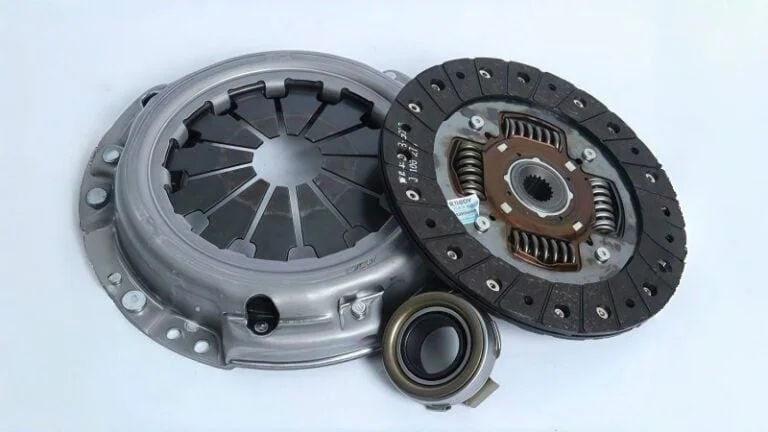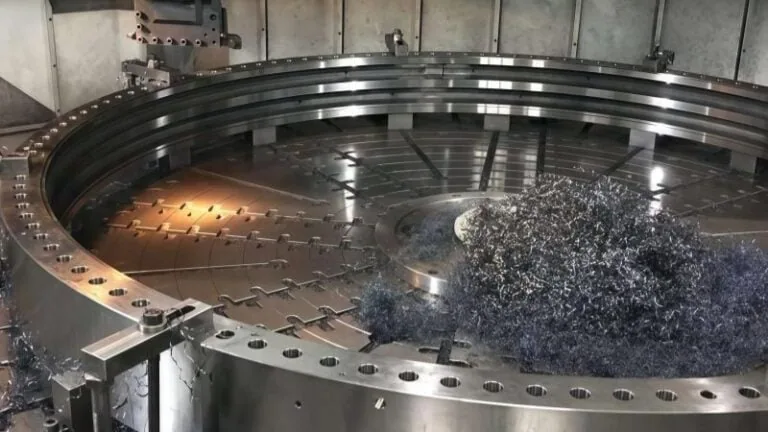-
Whatsapp: +86 13526572721
-
Email: info@zydiamondtools.com
-
Address: AUX Industrial Park, Zhengzhou City, Henan Province, China
-
Whatsapp: +86 13526572721
-
Email: info@zydiamondtools.com
-
Address: AUX Industrial Park, Zhengzhou City, Henan Province, China

What Are PDC Cutters and Why Are They a Game-Changer in Modern Drilling?
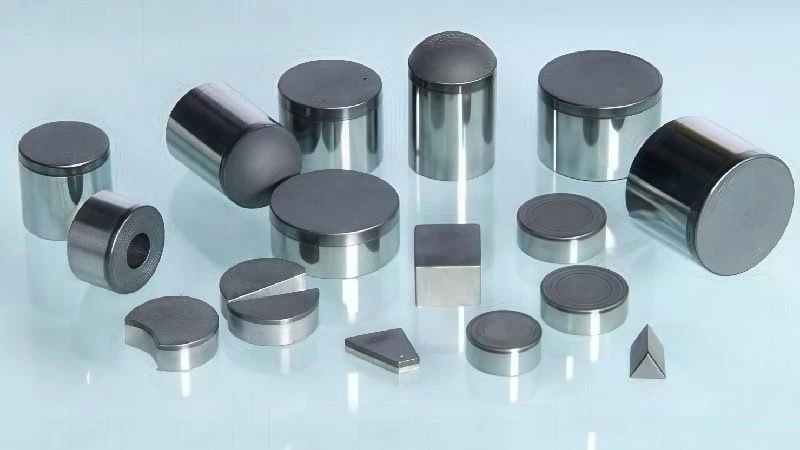
So, what exactly is a Polycrystalline Diamond Compact (PDC) cutter, and why has it become so critical for modern drilling operations?
A Polycrystalline Diamond Compact (PDC) cutter¹ is an advanced cutting tool made by fusing a layer of synthetic, polycrystalline diamond onto a tough tungsten carbide substrate. They are a game-changer in drilling because their unique shearing action enables dramatically faster drilling speeds, longer tool life, and greater efficiency compared to traditional methods, significantly lowering costs in demanding industries like oil and gas, geothermal energy, and mining.
Engineering for Extreme Hardness and Durability
The engineering behind this simple-looking component is a sophisticated blend of material science and high-pressure physics. A PDC cutter isn’t just a single material; it’s a carefully designed composite where each part plays a critical role in its overall performance. Let’s break down how these materials are chosen and fused together to create a tool that can shear through solid rock.
The Core Anatomy: Diamond Layer and Carbide Substrate
Think of a PDC cutter like a piece of advanced armor. It has an incredibly hard outer layer to face the attack, supported by a tougher, more shock-absorbent backing. These two parts, the diamond layer and the carbide substrate, are fused into one piece.
- The Diamond Layer: This is the cutting edge and the primary working surface. However, it’s not a single, large gemstone like one you’d see in jewelry. Instead, it’s polycrystalline diamond². Imagine building a wall. A single large pane of glass would be very hard but would shatter completely if it cracked. A wall made of thousands of small, interlocking bricks, however, is far more durable. If one brick cracks, the damage doesn’t spread. This is the principle behind the polycrystalline diamond layer; it’s made of countless microscopic diamond crystals bonded together, providing exceptional hardness and wear resistance without being brittle.
- The Carbide Substrate: This is the foundation of the cutter, typically made from tungsten carbide³. Its main job isn’t to cut, but to provide mechanical support to the ultra-hard diamond layer. Tungsten carbide is extremely tough and resistant to high-impact forces. Crucially, it also has a thermal expansion rate that is manageable when bonded to diamond, and it provides a sturdy base that can be brazed (a type of high-temperature soldering) onto the body of a drill bit.
Here is a simple breakdown of their roles:
| Component | Material | Primary Function |
|---|---|---|
| Diamond Layer | Polycrystalline Diamond (PCD) | Provides extreme hardness for cutting and abrasion resistance. |
| Carbide Substrate | Tungsten Carbide (WC) | Offers impact strength (toughness) and a weldable base for the drill bit. |
The High-Pressure, High-Temperature (HPHT) Sintering Process
How do you permanently fuse the world’s hardest material to a tough metal base? The answer lies in a manufacturing process that recreates the conditions deep within the Earth where diamonds are naturally formed. This is the High-Pressure, High-Temperature (HPHT) process.
Essentially, the process involves placing the tungsten carbide substrate in a special press, covering it with a carefully measured layer of micron-sized synthetic diamond powder, and often including a catalyst metal like cobalt. The machine then applies immense force and heat.
Creating the Unbreakable Bond
Inside the HPHT press, the conditions are extreme, typically in the range of 5 to 7 Gigapascals (GPa) of pressure and 1,400°C to 1,600°C of heat. For perspective, 5 GPa is over 700,000 pounds per square inch—like stacking dozens of cars onto a surface the size of a coin.
Under this immense pressure and heat, the catalyst metal melts and flows into the spaces between the diamond particles. This serves two purposes:
- It helps the individual diamond crystals sinter, or fuse together, forming the solid polycrystalline layer.
- It helps bond the entire diamond layer directly to the tungsten carbide substrate.
The result is not two pieces glued together, but a single, integrated component with a seamless transition between the layers. These precise conditions are carefully controlled and tailored by manufacturers for each cutter grade to achieve an optimal balance of hardness and toughness.
Understanding the Critical Diamond-to-Carbide Interface
The single most important factor for a PDC cutter’s durability is the quality of the bond between the diamond layer and the carbide substrate. This meeting point is called the interface. If this interface fails, the cutter experiences “delamination”—where the diamond table shears off the substrate, rendering it useless, no matter how much diamond is left.
Think of it like the adhesive between the rubber tread and the main body of a car tire. If that adhesive fails, the tread can peel off, causing a catastrophic failure, even if the tread itself is perfectly fine.
A well-engineered interface is designed to manage the stress that builds up between the two very different materials. Diamond is extremely rigid, while tungsten carbide has more give. When the cutter hits rock, immense force travels through the cutter. A poor interface concentrates this stress in one spot, leading to a crack. A superior interface, however, is designed to distribute that stress evenly, preventing a single point of failure.
Manufacturers spend significant research and development effort perfecting this interface. They do this by controlling the surface geometry of the substrate (sometimes using non-flat designs), managing the amount of catalyst that flows into the diamond layer, and refining the HPHT process to create a bond that is as strong as the materials themselves.
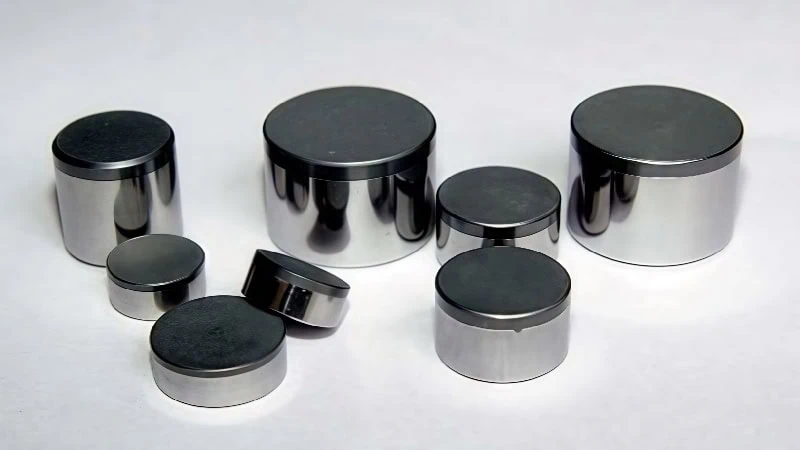
Dominant Applications in Key Industries
While their engineering is impressive, it’s their performance in specific environments that truly sets them apart. A PDC cutter’s ability to continuously shear rock, rather than crush it, makes it the tool of choice for industries where speed and durability directly translate into major cost savings. Let’s explore the key sectors where PDC technology has become the standard.
Oil & Gas Exploration (Shale, Sandstone, and Limestone)
The oil and gas industry is, by far, the largest user of PDC cutters. Modern drilling, especially for unconventional resources like shale gas, would be far less economical without them. Their success here is tied to one key factor: Rate of Penetration (ROP).
Mastering Long, Continuous Drilling Sections
In massive shale plays like the Permian Basin in Texas or the Bakken Formation in North Dakota, drilling operations involve creating incredibly long horizontal wells that can extend for miles through a single type of rock. This is where PDC bits⁴ shine.
- Shearing vs. Crushing: Unlike older bit types that chip away at rock, a PDC bit acts more like a blade on a wood plane, shearing off rock in a continuous motion. This is highly efficient in consistent sedimentary rocks like shale and sandstone.
- Single-Run Performance: The goal is always to drill as much of a section as possible in a “single run” without having to pull the entire drill string out of the hole to change the bit. Every “trip,” as it’s called, costs a significant amount of time and money. The durability of PDC cutters allows a single bit to drill thousands of feet, making them ideal for these long sections.
For example, a modern PDC bit can often increase ROP by 30-50% or more compared to older technologies in the right formation. Of course, performance gains like this are highly dependent on the specific drilling parameters and rock type, so it’s always wise to consult bit supplier data for the application you’re targeting.
Geothermal Energy Drilling (Hard and Abrasive Rock)
Drilling for geothermal energy presents a unique set of challenges: extremely hard, abrasive, and often very hot rock like granite and basalt. While this is a tough environment for any tool, specialized PDC cutters have been developed to handle these conditions.
The main enemy here is heat. Standard PDC cutters can fail when high temperatures cause the diamond to break down. However, advanced PDC cutters are now engineered for superior thermal stability.
Overcoming Heat and Abrasion
Manufacturers create these cutters using processes that minimize the metallic catalyst left in the diamond layer. This makes them much more resistant to thermal degradation.
In geothermal projects, such as those in Iceland or California, drillers encounter hard igneous rock that can quickly wear down conventional bits. A thermally stable PDC bit can maintain its sharp cutting edge for much longer, even at temperatures exceeding 300°C (572°F). This means:
- Fewer bit changes are needed to reach the hot target zones.
- Drilling stays on schedule and within budget.
- Overall project viability is improved.
Mining and Construction (Tunnel Boring and Foundation Work)
In mining and civil engineering, PDC cutters are used more as individual components on massive machinery rather than on a traditional drill bit. Their role here is all about long-term, predictable wear and efficiency.
The Cutting Edge of Mega-Machines
Think of the enormous Tunnel Boring Machines (TBMs)⁵ used to dig subway and water tunnels. The rotating head of a TBM is studded with hundreds of cutting tools. Equipping these heads with PDC cutters provides several advantages:
- Consistent Wear: PDC cutters provide a smooth, consistent cutting action that leads to a more predictable wear life.
- Reduced Downtime: Replacing cutters on a TBM head deep inside a tunnel is a major, time-consuming operation. The long life of PDC cutters extends the time between these maintenance shutdowns.
- Efficiency: They efficiently excavate rock in large-scale civil projects and in mining applications like raise boring, where large vertical shafts are created.
In these applications, the value of a PDC cutter isn’t just its speed, but its reliability and the role it plays in keeping these massive, multi-million-dollar projects moving forward with minimal interruption.

Key Features That Determine Performance
Not all PDC cutters are created equal. Engineers can change several key design elements to tailor a cutter for a specific rock formation or drilling challenge. Understanding these features is key to understanding why a certain drill bit is chosen for a job. Think of it as choosing the right tire for your car—some are built for speed on a smooth track, while others are designed for grip in rough terrain.
Cutter Size and Geometry (From Flat to Domed)
The physical size and shape of the cutter are the first things you’ll notice, and they play a huge role in how the entire drill bit behaves.
Size and Its Effect on the Bit
Cutters come in various standard diameters, typically measured in millimeters. Common sizes include 13mm, 16mm, and 19mm. The choice of size involves a trade-off:
- Larger Cutters (e.g., 19mm): These are individually stronger and more durable. A bit with larger cutters can take a bigger “bite” out of the rock and is often more robust in tougher drilling.
- Smaller Cutters (e.g., 13mm): These allow a bit designer to place more cutters on the face of the drill bit. This can increase the overall rate of penetration (ROP) in certain applications and provide a smoother, more stable drilling operation.
It’s worth remembering that while sizes are standardized, specific dimensions and tolerances can vary slightly between manufacturers, so it’s good practice to confirm details with your supplier.
Geometry: The Shape of Aggression
Beyond just size, the shape of the cutter’s face is critical. This is where engineers fine-tune a bit’s “aggressiveness.”
| Cutter Geometry | Primary Characteristic | Best Use Case |
|---|---|---|
| Flat Face | High Aggressiveness | Softer, uniform formations where achieving the highest ROP is the goal. |
| Domed/Conical | High Durability | Hard, interbedded, or fractured formations requiring high impact resistance. |
| Ridged/Shaped | Specialized Performance | Designed to create specific rock fracture patterns or improve cleaning. |
A flat-faced cutter is like a sharp chisel, aggressively shearing away rock. A domed cutter, on the other hand, is more like a hammer, designed to withstand heavy impacts without chipping.
Diamond Grit Size (Balancing Abrasion vs. Impact Resistance)
The “polycrystalline” diamond layer isn’t a solid crystal; it’s made of microscopic diamond particles, or “grit,” fused together. The size of this grit is one of the most important factors in a cutter’s performance, creating a critical balance between two key properties.
This is the core trade-off:
- Fine Grit (Smaller Diamond Particles): Think of fine-grit sandpaper. It creates a very sharp, smooth edge that is excellent at resisting abrasive wear. These cutters excel in formations like sandstone, which can quickly dull a lesser tool. However, this sharpness comes at the cost of being more brittle and prone to chipping on impact.
- Coarse Grit (Larger Diamond Particles): Now think of coarse-grit sandpaper. The larger particles create a tougher, more durable structure that is highly resistant to chipping and impact. These cutters are used for rough drilling through inconsistent layers or broken rock where impacts are common. The trade-off is that they have lower abrasion resistance.
Therefore, a drilling engineer will select a cutter with a grit size specifically matched to the expected geology to maximize the bit’s life and performance.
Edge Design: Chamfers and Bevels
What’s the most vulnerable part of a brand-new cutter? The razor-sharp cutting edge. A perfectly sharp edge can easily chip the first time it hits hard rock, leading to premature failure. To solve this, engineers add a feature called a chamfer.
A chamfer is a small bevel or angled surface ground onto the outer edge of the cutter face.
Imagine the tip of a freshly sharpened pencil. A perfect, needle-like point will snap with very little pressure. But if you slightly round that tip, it becomes much more durable. A chamfer does exactly the same thing for a PDC cutter. It reinforces the cutting edge to prevent micro-chipping, which can grow into larger fractures.
By adding a chamfer, engineers sacrifice a tiny amount of initial sharpness for a massive increase in overall durability. This simple feature is one of the most effective ways to improve a cutter’s impact resistance and ensure it has a long, productive life downhole. The size and angle of the chamfer can be adjusted to provide more or less protection, depending on how tough the drilling conditions are expected to be.
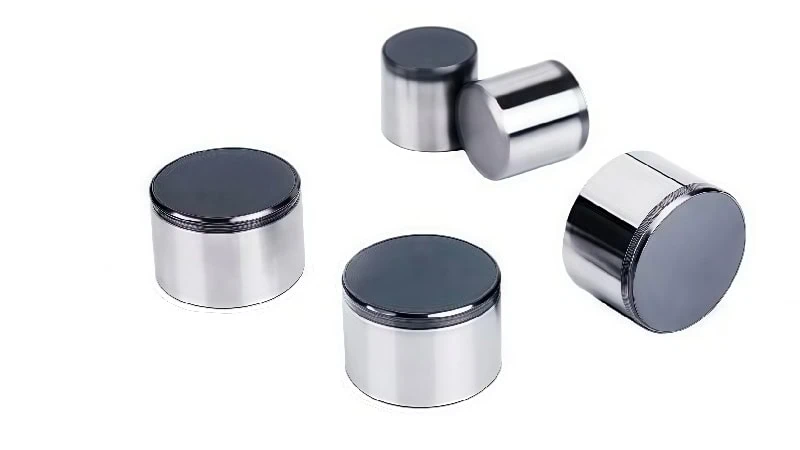
How Do They Compare to Traditional Tungsten Carbide Insert (TCI) Bits?
So, if PDC bits are so effective, why does anyone still use the older TCI bits?
PDC bits drill faster by shearing rock, making them ideal for long, consistent formations, while TCI bits drill by crushing rock with tough tungsten carbide inserts, making them more durable and reliable in very hard, fractured, or unpredictable ground. The choice depends on balancing the need for speed against the need for impact resistance.
Before PDC bits became the standard in many applications, the industry relied heavily on Tungsten Carbide Insert (TCI) bits, also known as roller cone or tri-cone bits. They are still widely used today and remain the superior choice in certain conditions.
The most important difference to understand is how they break rock. A PDC bit is a fixed-cutter bit that has no moving parts and works like a plow, shearing the rock away. A TCI bit is a roller cone bit with moving cones studded with hard buttons that crush and gouge the rock. This fundamental difference in mechanics dictates their speed, lifespan, and ideal use cases.
Rate of Penetration (ROP) and Drilling Speed
When it comes to pure speed in the right environment, there is often a clear winner.
The Shearing Advantage of PDC Bits
Because a PDC bit scrapes away rock in a continuous shearing motion, it can achieve a much higher Rate of Penetration (ROP). With no moving parts like cones or bearings, 100% of the bit’s rotation contributes directly to cutting the rock. In long stretches of consistent rock like shale or sandstone, this translates into drilling a section much faster, saving valuable time and money.
The Crushing Method of TCI Bits
TCI bits work by concentrating high pressure onto small points—the tungsten carbide inserts—to crush and fracture the rock as the cones roll along the bottom of the hole. While very powerful, this action is less efficient than shearing. The motion of the rolling cones means the cutting action is not continuous, which inherently limits the maximum achievable ROP compared to a PDC bit in optimal conditions.
Lifespan and Wear Characteristics
How a bit wears out and eventually fails is just as important as how fast it drills. The two bit types fail in very different ways.
- PDC Bit Wear: A PDC bit’s primary enemy is abrasion. Over time, the hard rock wears down the diamond table, making the cutters dull and less effective. They are also vulnerable to severe impacts, which can cause the diamond layer to chip or break off completely (a failure known as delamination).
- TCI Bit Wear: A TCI bit has more potential points of failure. The individual carbide inserts can become heavily worn, chipped, or break off entirely. However, the most critical failure mode is often the bearings. The cones spin on bearings that can wear out from heat and friction. If a bearing fails, the cone can lock up, and the bit will quickly destroy itself.
Ideal Operating Conditions and Limitations
Ultimately, the choice between a PDC and TCI bit comes down to finding the right tool for the job. Neither is better in all situations. The geology of the formation is the primary deciding factor.
Here is a direct comparison of their ideal operating windows:
| Feature | PDC (Polycrystalline Diamond Compact) Bits | TCI (Tungsten Carbide Insert) Bits |
|---|---|---|
| Drilling Mechanism | Shearing: Fixed cutters scrape rock continuously. | Crushing & Gouging: Rotating cones with inserts crush rock. |
| Ideal Rock Type | Soft to medium-hard, homogeneous formations (shale, sandstone, limestone). | Very hard, abrasive, or “interbedded” formations (alternating hard/soft layers). |
| Key Advantage | High Rate of Penetration (ROP) and drilling speed. | High durability and reliability in unpredictable or impactful conditions. |
| Primary Limitation | Susceptible to impact damage in hard or broken rock. | Slower ROP; has moving parts that can fail (bearings). |
| Common Failure Mode | Abrasive wear, chipping, or delamination of cutters. | Worn/broken inserts, or bearing failure leading to locked cones. |
So, what does this mean in practice? An oil and gas company might use a tough TCI bit to drill through the first few hundred feet of a well where the rock layers are varied and unknown. Then, once they reach the target shale formation, which is thousands of feet thick and very consistent, they will switch to a PDC bit to drill the rest of the well as fast as possible.
Conclusion
From their microscopic origins in a high-pressure press to their large-scale impact on global energy and construction, Polycrystalline Diamond Compact cutters represent a triumph of material science. They are not just simple components; they are highly engineered tools born from the fusion of the world’s hardest material with an incredibly tough substrate.
Their dominance in applications like oil and gas drilling is a direct result of their efficient shearing action, which provides unparalleled speed in the right conditions. However, performance is not one-size-fits-all. The ability to customize a cutter’s geometry, size, and diamond grit allows engineers to create specialized tools for specific challenges, from drilling through hot, abrasive geothermal rock to boring massive transportation tunnels.
While they have revolutionized drilling, they exist within a broader toolbox. The comparison with TCI bits highlights a crucial lesson: the most advanced technology is only effective when applied correctly. The PDC cutter’s story is one of targeted innovation, where understanding its strengths (speed and efficiency) and limitations (impact resistance) allows industries to drill farther, faster, and more economically than ever before.
References
- Polycrystalline Diamond Compact (PDC) cutter¹ – The main product page for PDC cutters on ZYDiamondTools, providing specifications and application details.
- polycrystalline diamond² – An in-depth article from ZYDiamondTools explaining the key material properties of PCD, including hardness, toughness, and wear resistance.
- tungsten carbide³ – Wikipedia’s comprehensive page on tungsten carbide, detailing its properties, production, and applications.
- PDC bits⁴ – A ZYDiamondTools product category page showcasing various PDC bits and related drilling tools.
- Tunnel Boring Machines (TBMs)⁵ – Wikipedia’s detailed article explaining what TBMs are, how they work, and their history.

